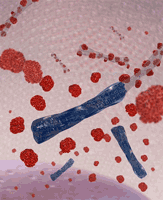Scientists identify a cause of Alzheimer's and find remedy
By By Susan Brown | 11 Nov 2010
Researchers suspect that a protein superstructure called amyloid beta is responsible for much of the neural da mage of Alzheimer's disease.
 |
| Coating with a drug candidate (blue) inhibits interaction between amyloid beta and other proteins, like the antioxidant enzyme catalase. Illustration by Christopher Burke. |
A new study at the University of California, San Diego, shows that amyloid beta disrupts one of the brain's anti-oxidant proteins and demonstrates a way to protect that protein, and perhaps others, from amyloid's harmful effects.
''Amyloid seems to cause damage to cells,'' said chemistry professor Jerry Yang. ''We have reported in a very detailed way one potential interaction of how amyloid can cause disease, and we found a way to stop it.'' His group's report of their results will appear in the Journal of Biological Chemistry in December.
 Their study focused on catalase, an enzyme that mops up excess oxidants, because catalase normally helps to prevent the kind of damage seen in the brains of patients with Alzheimer's disease and previous work had found catalase proteins deposited within amyloid plaques.
Their study focused on catalase, an enzyme that mops up excess oxidants, because catalase normally helps to prevent the kind of damage seen in the brains of patients with Alzheimer's disease and previous work had found catalase proteins deposited within amyloid plaques.
Lila Habib, a bioengineering graduate student and the first author of the report, added amyloid to cultured neural cells and looked at its effects.
''We were able to determine that amyloid beta and this anti-oxidant enzyme, catalase, interact, and that this interaction harmed catalase so it wasn't able to perform its physiological function: to degrade hydrogen peroxide into oxygen and water,'' she said.
When Habib coated the amyloid with a small molecule designed to prevent its interaction with other proteins, she was able to restore the activity of catalase and return hydrogen peroxide to normal levels within the cells.